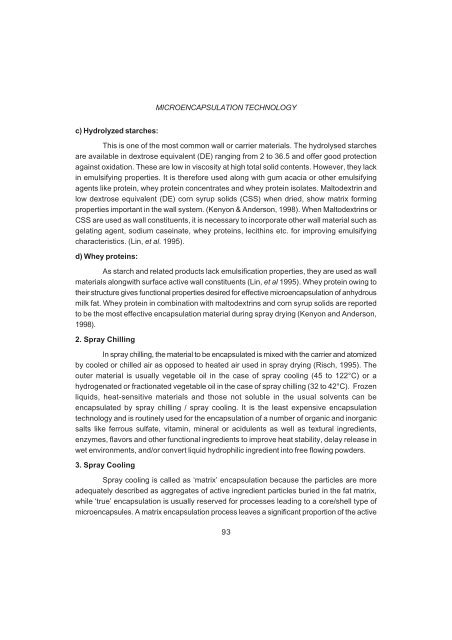Download (60Kb)
Download (60Kb)
Download (60Kb)
Create successful ePaper yourself
Turn your PDF publications into a flip-book with our unique Google optimized e-Paper software.
c) Hydrolyzed starches:<br />
This is one of the most common wall or carrier materials. The hydrolysed starches<br />
are available in dextrose equivalent (DE) ranging from 2 to 36.5 and offer good protection<br />
against oxidation. These are low in viscosity at high total solid contents. However, they lack<br />
in emulsifying properties. It is therefore used along with gum acacia or other emulsifying<br />
agents like protein, whey protein concentrates and whey protein isolates. Maltodextrin and<br />
low dextrose equivalent (DE) corn syrup solids (CSS) when dried, show matrix forming<br />
properties important in the wall system. (Kenyon & Anderson, 1998). When Maltodextrins or<br />
CSS are used as wall constituents, it is necessary to incorporate other wall material such as<br />
gelating agent, sodium caseinate, whey proteins, lecithins etc. for improving emulsifying<br />
characteristics. (Lin, et al. 1995).<br />
d) Whey proteins:<br />
As starch and related products lack emulsification properties, they are used as wall<br />
materials alongwith surface active wall constituents (Lin, et al 1995). Whey protein owing to<br />
their structure gives functional properties desired for effective microencapsulation of anhydrous<br />
milk fat. Whey protein in combination with maltodextrins and corn syrup solids are reported<br />
to be the most effective encapsulation material during spray drying (Kenyon and Anderson,<br />
1998).<br />
2. Spray Chilling<br />
In spray chilling, the material to be encapsulated is mixed with the carrier and atomized<br />
by cooled or chilled air as opposed to heated air used in spray drying (Risch, 1995). The<br />
outer material is usually vegetable oil in the case of spray cooling (45 to 122°C) or a<br />
hydrogenated or fractionated vegetable oil in the case of spray chilling (32 to 42°C). Frozen<br />
liquids, heat-sensitive materials and those not soluble in the usual solvents can be<br />
encapsulated by spray chilling / spray cooling. It is the least expensive encapsulation<br />
technology and is routinely used for the encapsulation of a number of organic and inorganic<br />
salts like ferrous sulfate, vitamin, mineral or acidulents as well as textural ingredients,<br />
enzymes, flavors and other functional ingredients to improve heat stability, delay release in<br />
wet environments, and/or convert liquid hydrophilic ingredient into free flowing powders.<br />
3. Spray Cooling<br />
MICROENCAPSULATION TECHNOLOGY<br />
Spray cooling is called as ‘matrix’ encapsulation because the particles are more<br />
adequately described as aggregates of active ingredient particles buried in the fat matrix,<br />
while ‘true’ encapsulation is usually reserved for processes leading to a core/shell type of<br />
microencapsules. A matrix encapsulation process leaves a significant proportion of the active<br />
93
















